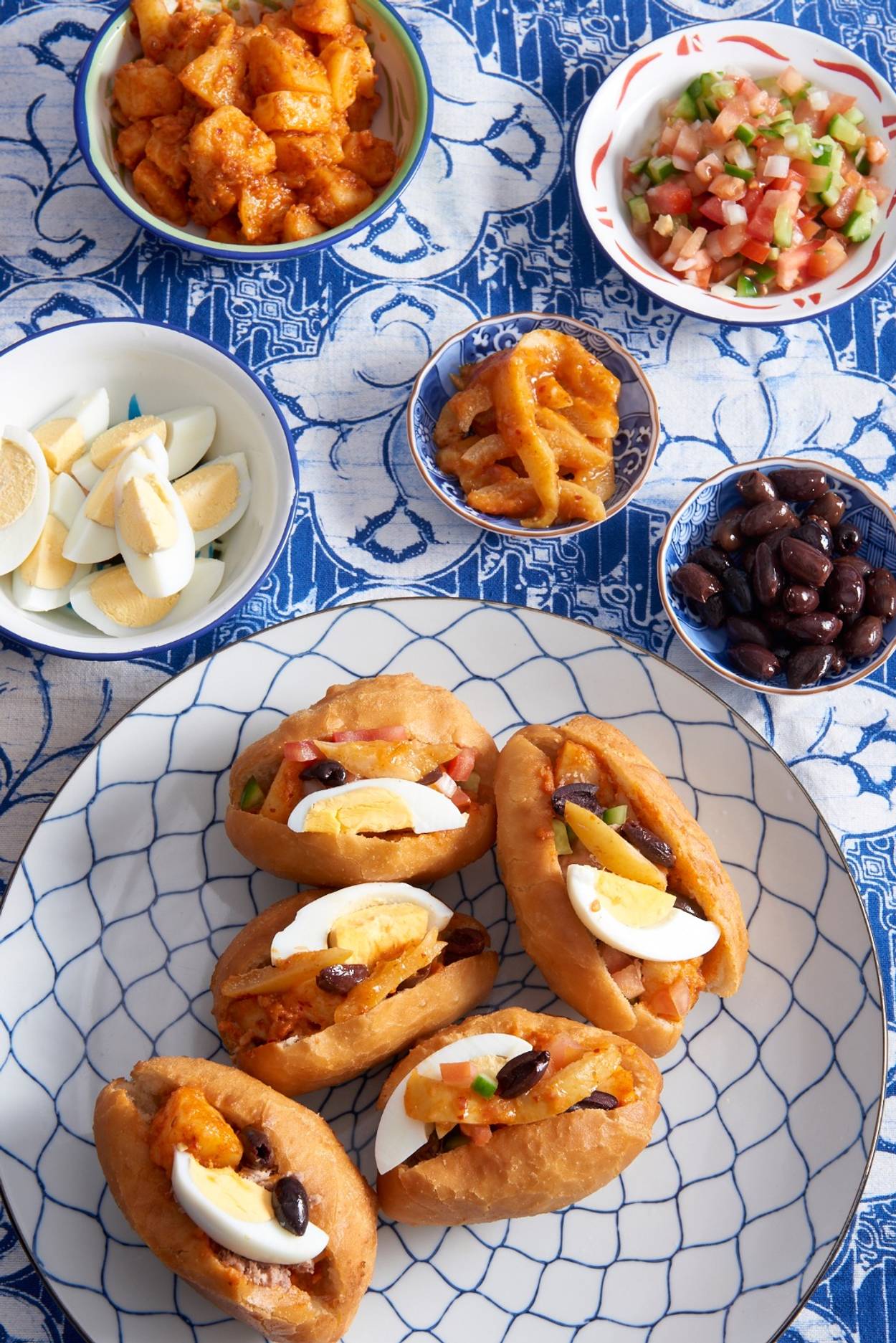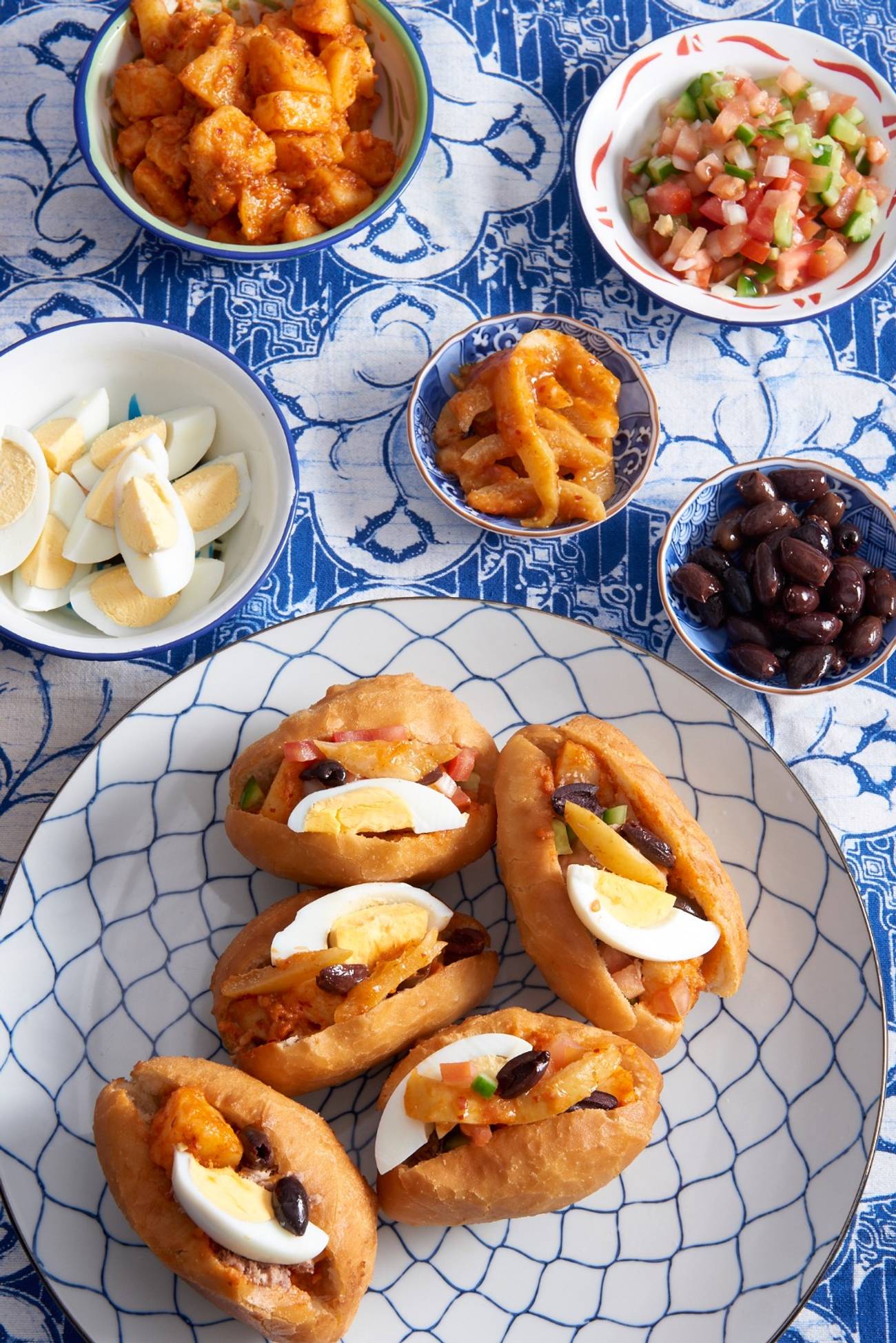A Guilty Pleasure for Israeli Independence Day
Deep-fried Tunisian tuna sandwiches known as fricassé are popular across Israel—especially, for some, on Yom Ha’atzmaut




For Pascale Perez-Rubin—cookbook author, food writer at Maariv and Jerusalem Post, and a self-described anthropologist of Jewish cooking by different ethnic groups—Tunisian fricassé is an Israeli Independence Day tradition. “Every Yom Ha’atzmaut, my family would gather at my mother’s house in Ramle for fricassé,” Tunisian-born Perez-Rubin told me. The dish has nothing to do with the homonymous meat stew, except for the French origin of the name—after all, Tunisia was under French rule from 1881 until its independence in 1956. Instead, Tunisian fricassé is basically a spicy tuna sandwich, deep-fried inside a doughnut.
“Most Israeli families have a barbecue on Yom Ha’atzmaut—the traditional ‘al ha-esh’—but we always had fricassé,” said Perez-Rubin. “My mother’s explanation was that the fried bun looks like the ship in which the olim reached Israel and the filling is the Kibbutz Galuyot—the Gathering of Israel. The credit for this goes to my mother, Esther Perez, may she rest in peace. I wrote about this many times over the years so I’m sure other families liked the idea and adopted this tradition, too.”
Perez-Rubin was born in the coastal town of Nabeul in northeastern Tunisia—which had a Jewish community dating back to the expulsion of Jews from Spain in 1492—and came to Israel at a very young age. A couple of her cookbooks include fricassé recipes, so she’s an expert on its basics. “The fricassé is a deep-fried oval bun. After it’s extracted from the oil it is filled with tuna, hard-boiled eggs, and homemade pickles,” she told me. “Nowadays people use canned tuna in oil and store-bought pickles, but it doesn’t taste the same as when everything is homemade. Originally the tuna fish was preserved at home, too. The pickles we put in a fricassé are pickled lemons, capers, and olives, especially black olives. The pickles might differ in different areas of Tunisia. Some add boiled potatoes, which are cut in small pieces, or a potato salad, which already includes the capers and olives. Whoever likes it spicy adds harissa (spicy pepper paste), but it’s not the same kind of harissa we use for cooking, it’s mixed with tomato puree, which makes it milder. There are also people who add other stuff, like matbucha. It tastes good but it’s not part of the original recipe.” Other things that one might find in a fricassé are spicy pumpkin spread or spicy carrot salad.
The bun itself, of course, is no less important than the filling. “The fried buns are similar to sufganiyot but the original buns are not very sweet—they had very little sugar in them,” Perez-Rubin continued. “In Israel, people usually add more sugar to the fricassé dough, which is a matter of taste. The sugar makes the buns darker in color, which is pretty, but not as the original buns used to be. They are supposed to be light in color, golden.”
Although Perez-Rubin credits her mother for making fricassé an Independence Day dish, Perez-Rubin’s family is not the only Tunisian family in Israel eating fricassé on Yom Ha’atzmaut. Whether they were influenced by Perez-Rubin’s writings or not, other Tunisian families in Israel hold the same tradition, and for good reason.
“Independence Day was a special day, which brought with it two exciting events: the annual International Bible Contest (in which participants compete on their knowledge of the Bible), and fricassé.” This is a quote from Shoshana Cohen-Levran’s cookbook Ya Amna—From Djerba to Israel: A Tunisian Family Kitchen. “Mom would prepare the dough early in the morning. She would fill the hot, fried rolls with tuna, potato salad, hard-boiled eggs, vegetable salad with parsley, and green onions … The origin of fricassé remains a bit of a mystery. The name surely has some relation to the French word "frit,” meaning “fried.” You can also see some connection between the fillings of the fricassé and the ingredients of a French niçoise salad (potatoes, eggs, tuna, olives), and we all know that the French ruled Tunisia for many years. In any case, fricassé is a celebratory dish for special occasions.”
The reason fricassé suits Yom Ha’atzmaut so well is that it’s a fun and festive dish that Tunisian Jews eat at parties, but cannot consume on religious holidays because it needs to be made fresh and eaten immediately. Perez- Rubin explained: “We eat fricassé at any happy occasion that’s not a holiday: at bar mitzvahs, brit milah events, pre-wedding henna ceremonies, birthday parties, any festive gathering.”
Ya Amna, which means “Our Mother” in Tunisian Arabic, started out as a family project: a birthday present that Cohen-Levran’s six daughters made their mother for her 70th birthday. Cohen-Levran never cooked professionally, but in her circle, she became renowned for her cooking, so her daughters compiled her Tunisian recipes—including fricassé—into a book, with family anecdotes about her food. Ofer Vardi, the publisher of LunchBox Press, fell in love with the project and proposed to publish a commercial version of the book (originally in Hebrew, followed by an English edition in 2020), which captures Cohen-Levran’s journey from Djerba, the Tunisian island where she was born, to Israel, where she grew up. In Israel, Shoshana’s older relatives taught her the secrets of traditional Tunisian cuisine. Much to the author’s surprise, the book ended up winning 2018’s Best Jewish Cookbook at the Gourmand Awards, the cookbook Oscars.
“Fricassé goes well with any special event that’s a ‘yom chol.’ A summer evening that all the family is together at home; the end of the school year; guests coming over; aunts, uncles and cousins visiting,” Ilanit Cohen Fridman, the designer of Ya Amna and one of Cohen-Levran’s daughters, told me. “And, of course, Yom Ha’atzmaut. We would go to a shop in the Krayot of Haifa and buy fresh tuna, which my mom would preserve. And every Yom Ha’atzmaut morning we would start making dough—either for pitot if we’re having a barbecue that year, or for fricassé.”
Michal Gur, another of Cohen-Levran’s daughters, added: “When making the dough, you ask for a blessing so that it succeeds. You want it to rise and be fluffy. When it begins to rise, it automatically makes you smile. With this smile you send your blessings: to the safety of IDF soldiers, to a birth, to a marriage, and blessings for singles to find a mate.”
Cohen Fridman traces the origin of the fricassé to Tunis, the capital of Tunisia. “The people of Djerba, where my family came from, were simple people with simple food,” she told me. “But many of the men from Djerba went to work in the capital and I assume that’s where they first encountered fricassé. Tunis was a very central city and full of influences from the outside—mainly French and Italian. In the 19th century there were lots of Sicilians in Tunis and also Russians and Poles that fled Europe. There was obviously the French rule which brought with it the niçoise salad, which also includes tuna, hard-boiled eggs, and olives. And the fried dough is very similar to the Italian bombolone, which is a sweet doughnut.
“There is a belief that all Tunisian fried dishes originated in Sicily, which might be so, but most cuisines have their own version of doughnuts, which slightly differ and have different fillings,” she continued. “The fricassé dough is also similar to the sfenj dough but it’s not as soft, the texture is more like a challah. And the fricassé rolls are elongated so that you can fit all the fillings inside.”
There have been Jews in the area of Tunisia for more than 2,000 years. In 1948, when the state of Israel was established, there were about 105,000 Jews in Tunisia. Most of them immigrated either to Israel or to France. Many of the cosmopolitan Jews from Tunis immigrated to France; Jews from the island of Djerba, who were generally more religious, made aliyah. Nowadays, there are a little over 1,000 Jews left in Tunisia, most of them in Djerba, which still has a small Jewish community. The rest brought their fricassé recipes to Israel.
Fricassé is probably a Jewish invention. There is a legend that a Jewish Tunisian woman in the 19th century made fried dough fritters for dessert for her guests. When they didn’t show up, she was stuck with a large number of fritters, so she decided to turn them into the main course instead. She didn’t sprinkle them with sugar as she had intended. Instead, she stuffed them with whatever she could find in her pantry to make a savory meal. Her family and neighbors loved it, and so—according to legend—the fricassé was born. This tale can be found online, but most of the experts I talked to never heard of it.
In Israel, fricassé has become a guilty pleasure—because it is obviously calorie-rich—consumed not only in Tunisian family celebrations, but it is also a beloved fast-food. It is not as prevalent as falafel, shawarma, and sabich, but it has many fans. And similarly to falafel, shawarma, and sabich, when ordering fricassé at a food stand, canteen, or snack bar in Israel, you tell the vendor which fillings you want to include, and, of course, how spicy you want it.
One of the first times I tasted fricassé was a long time ago on a trip to the holy city of Safed in the Galilee. Fricassé Zehava is a culinary landmark of the city, literally a hole in the wall on Safed’s busy main street, Jerusalem Street. Zehava Lagziel opened it in the late 1980s. Her parents came to Israel from Nabeul and Lagziel learned how to cook from her mother and grandmother. In her stand she serves shakshuka, couscous, falafel, meat and fish dishes, and the famous Maghrebi doughnut sfenj for dessert. But her pièce de resistance is her fricassé. Fans of Zehava’s cooking come to her shabby looking establishment from all over the country and queue to take home her delicacies. She also has a few tables and plastic chairs outside for whoever wants to eat on premises.
In addition to the traditional deep-fried fricassé, Zehava serves another version, with the same filling, but in a baked bun, which she explained is for “people who care about their figure.”
In today’s health-conscious times, fewer places across the country serve real fricassé, meaning in the original fried buns. Many serve the same fillings in a baguette (or rather the Israeli version of a baguette, which is more like a long bun). Some have the gall to call that a fricassé. Others call it a Tunisian sandwich, which is much more accurate.
“I have no problem if people put the same fillings in a baguette or other kinds of bread, as long as they don’t call it fricassé,” said Perez-Rubin. “A fricassé must be deep-fried. If it’s in a baguette, it’s still tasty but it’s not a fricassé. It’s an Israeli invention and it must be called a Tunisian sandwich.”
Dana Kessler has written for Maariv, Haaretz, Yediot Aharonot, and other Israeli publications. She is based in Tel Aviv.